What I'd suggest if you want to proceed conservatively is just solder on pin4 and 5 (power pins) for each new chip you add to the stack. Then power up and measure pin7 voltage with a DMM. If that's in spec, stack another chip on top and repeat. When all chips are included, solder all the rest of the pins (keeping pin7 floating on each). Measuring pin7 voltage is the best way I know to see if the DAC's broken or not.
Do take a lot of care if just using solder to make the connections between pins in a stack, its surprisingly easily to get an open which can be almost invisible to the eyes. Always measure connectivity from top to bottom with a DMM.
Do take a lot of care if just using solder to make the connections between pins in a stack, its surprisingly easily to get an open which can be almost invisible to the eyes. Always measure connectivity from top to bottom with a DMM.
QuadPhi is live!
So I put the four-stack Phidac together and surprisingly it worked upon power up. Soldering those little sugar ants by hand is a full day event for a novice like me and soldering 4 dacs on top of each other was harder than I thought it would be. If it didn't work, I would not have had any clue where to look to see what was wrong, so Yay!
I will reserve my sound opinion for a few days and let everything burn in a bit. (but it does sound really good in the first 5 minutes)
So I put the four-stack Phidac together and surprisingly it worked upon power up. Soldering those little sugar ants by hand is a full day event for a novice like me and soldering 4 dacs on top of each other was harder than I thought it would be. If it didn't work, I would not have had any clue where to look to see what was wrong, so Yay!
I will reserve my sound opinion for a few days and let everything burn in a bit. (but it does sound really good in the first 5 minutes)
Very pleased to hear that @pelopidas 🙂
Yes its very fiddly stacking DACs at first, I guess I've done it so many times that I don't think about it much. Looking forward to hearing how the SQ has changed from original!
Yes its very fiddly stacking DACs at first, I guess I've done it so many times that I don't think about it much. Looking forward to hearing how the SQ has changed from original!
As the PhiDAC hex doesn't drive headphones directly I designed this headphone amp to partner it. Its very simple and has low BOM cost, using the JFET input AD744 with a classA SE output stage. A couple of prototypes have been built and here is the first PCB layout. Would there be any interest in kits of this too? PCB size is 10 * 4.5cm - JLCPCB currently has a special which gets us 5 PCBs for 5RMB, including shipping. Normally shipping alone costs more than this 😀
I interest just wondering it does need different power supply or just hooked together with PhiDAC ?
will you post secret sauce / schematic ?
Preliminary listening

Right now I am using Muse Bipolar 1000uf on all electrolytic positions as they sound very neutral to me. This is a baseline to see how the Quad sounds before tuning it with other caps.
First impressions is that the treble sounds faster and bass is fuller. This is not a night and day difference but it is noticeable. Background is blacker, less noise for sure. High hats are a bit clearer. The rasp of cello strings being bowed is clearer. Reverb decay trails a bit longer. Bass is a bit fuller, stronger, clearer. Basically if Phidac was 10 this turns it up to 11 🙄
Now to start rolling the caps. My first Phidac was tuned to sound soo damn sexy. It is lush and warm and relaxing. I can listen to it all day without fatigue. The quad is not fatiguing either even though there is definitely better detail retrieval going on. I know this because I am hearing "new" things in recordings compared to the single chip version. As it currently is configured with the Muse caps it is not as lush in the midrange. I am pretty sure this is from the different caps that are on the original.
I will update this once I have played around with it for a bit. Overall it is a nice step up.
I see why Abraxalito likes the 1387. There seems to be a whole lot of performance that can be teased out of this little chip.
I am wondering about something though. I was measuring the voltage on C21 and C22 and they are different. C21 is at 4v and C22 is 3.17v. Does that mean that one of the dac chips is defective or is it normal? I don't hear any noise out of either channel.
Just in case it matters C11 is 3.86v, C31 is at 12v, C10 is 5.85, C5 is at 7.72v, C16 is at 7.72v. Continuity was checked on the chips as you suggested and all are soldered from top to bottom.

Right now I am using Muse Bipolar 1000uf on all electrolytic positions as they sound very neutral to me. This is a baseline to see how the Quad sounds before tuning it with other caps.
First impressions is that the treble sounds faster and bass is fuller. This is not a night and day difference but it is noticeable. Background is blacker, less noise for sure. High hats are a bit clearer. The rasp of cello strings being bowed is clearer. Reverb decay trails a bit longer. Bass is a bit fuller, stronger, clearer. Basically if Phidac was 10 this turns it up to 11 🙄
Now to start rolling the caps. My first Phidac was tuned to sound soo damn sexy. It is lush and warm and relaxing. I can listen to it all day without fatigue. The quad is not fatiguing either even though there is definitely better detail retrieval going on. I know this because I am hearing "new" things in recordings compared to the single chip version. As it currently is configured with the Muse caps it is not as lush in the midrange. I am pretty sure this is from the different caps that are on the original.
I will update this once I have played around with it for a bit. Overall it is a nice step up.
I see why Abraxalito likes the 1387. There seems to be a whole lot of performance that can be teased out of this little chip.
I am wondering about something though. I was measuring the voltage on C21 and C22 and they are different. C21 is at 4v and C22 is 3.17v. Does that mean that one of the dac chips is defective or is it normal? I don't hear any noise out of either channel.
Just in case it matters C11 is 3.86v, C31 is at 12v, C10 is 5.85, C5 is at 7.72v, C16 is at 7.72v. Continuity was checked on the chips as you suggested and all are soldered from top to bottom.
QuadPhi review
After letting the quad burn in and testing back and forth between the original and the quad I have come to an interesting conclusion.
When I first put the original Phidac together, I was adding and removing and pairing (hats and pants) all kind of capacitors. The top end sounded soft and the bass while lovely needed help. After turning it into a ridiculous looking mess I had it sounding the best it could.
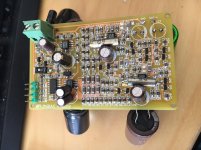
The top looks manageable but look at the bottom underneath.
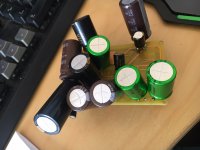
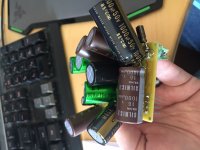
Now the Quad. I have spent all day listening, swapping, adding and came to the conclusion that it loves the Muse bipolars. 1000uf on all positions is all it takes. If anyone here has a better combo, let me know but nothing I have tried makes it better.
I am crediting the 4 DAC chips because this is the same board, same layout.
The original phidac that I put together has a midrange hump that is really sexy and the Quad does not. It sounds ruler flat. After doing alot of A B comparison the lushness of the midrange hump leads to less well defined sounds. A voice on the original sounds like its edges fade off hazily into the mix. The quad has defined dimensions. This definition is across the entire range. This cleans up the treble, making it clearer, faster, more detailed and thankfully not sibilant. The bass is tighter, showing detail and body that is not quite there in the original phidac.
Now, to be fair, the original has a tube like sound that is wonderful. The Quad is clean. It is not digital sounding like my 9018. It has tremendous detail but the little details don't have that artificial sparkle that ask for attention, rather it is liquid and smooth and musical. I said it was not a night and day difference and that is true but it is a qualitative difference that I am struggling to describe. It is better. My wife likes it more. She said it is the best she has ever heard. What else do I need to say? 😀
Also it looks clean with just the caps on the bottom.
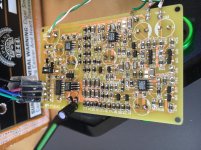
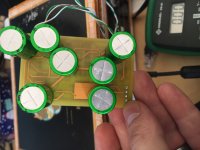
I have one little Cerafine cap that I put on the top in this picture, which I have since removed. This setup is damn near perfect. I don't know what else to do to it.
After letting the quad burn in and testing back and forth between the original and the quad I have come to an interesting conclusion.
When I first put the original Phidac together, I was adding and removing and pairing (hats and pants) all kind of capacitors. The top end sounded soft and the bass while lovely needed help. After turning it into a ridiculous looking mess I had it sounding the best it could.

The top looks manageable but look at the bottom underneath.


Now the Quad. I have spent all day listening, swapping, adding and came to the conclusion that it loves the Muse bipolars. 1000uf on all positions is all it takes. If anyone here has a better combo, let me know but nothing I have tried makes it better.
I am crediting the 4 DAC chips because this is the same board, same layout.
The original phidac that I put together has a midrange hump that is really sexy and the Quad does not. It sounds ruler flat. After doing alot of A B comparison the lushness of the midrange hump leads to less well defined sounds. A voice on the original sounds like its edges fade off hazily into the mix. The quad has defined dimensions. This definition is across the entire range. This cleans up the treble, making it clearer, faster, more detailed and thankfully not sibilant. The bass is tighter, showing detail and body that is not quite there in the original phidac.
Now, to be fair, the original has a tube like sound that is wonderful. The Quad is clean. It is not digital sounding like my 9018. It has tremendous detail but the little details don't have that artificial sparkle that ask for attention, rather it is liquid and smooth and musical. I said it was not a night and day difference and that is true but it is a qualitative difference that I am struggling to describe. It is better. My wife likes it more. She said it is the best she has ever heard. What else do I need to say? 😀
Also it looks clean with just the caps on the bottom.


I have one little Cerafine cap that I put on the top in this picture, which I have since removed. This setup is damn near perfect. I don't know what else to do to it.
The original phidac that I put together has a midrange hump that is really sexy and the Quad does not. It sounds ruler flat. After doing alot of A B comparison the lushness of the midrange hump leads to less well defined sounds. A voice on the original sounds like its edges fade off hazily into the mix. The quad has defined dimensions. This definition is across the entire range. This cleans up the treble, making it clearer, faster, more detailed and thankfully not sibilant. The bass is tighter, showing detail and body that is not quite there in the original phidac.
Now, to be fair, the original has a tube like sound that is wonderful. The Quad is clean. It is not digital sounding like my 9018. It has tremendous detail but the little details don't have that artificial sparkle that ask for attention, rather it is liquid and smooth and musical. I said it was not a night and day difference and that is true but it is a qualitative difference that I am struggling to describe. It is better. My wife likes it more. She said it is the best she has ever heard. What else do I need to say? 😀
Peolopidas,
Congrats on your getting PhiDAC singing with 4 chips! Your impressions of the midrange-centric sound of a single chip are spot-on with mine. Absolutely rich, present, and beautiful...and also sometimes leaves me wanting more detail around the edges, as you say. After being hooked on this sound for over a year, I recently ventured into new territory with the AD1865 and heard more details but missed the TDA magic. Now you say you have the best of both worlds...😱 What filter are you running on this one?
Abraxalito supplied the values for the filter.
Here is what he said.
"On your first question, I don't know. I haven't tried with just 2 chips, I figured why not stack up 4 for a first attempt as that'll give 6dB reduction in DAC noise and also improve the SNR of the following stages (by increasing the S without changes to the N). 4 chips is about the limit for the first filter which is made up of tiny (0805) inductors with a maximum current rating of 5mA (each DAC chip, running on 6V contributes 1.2mA).
The filter that needs to change for 4 chips isn't the first stage (CLC) one, its the second stage (active) one. That changes because its not just a filter, its also a gain stage and we need lowered gain when the DACs put out more current. If we didn't lower the gain the output would clip at -12dBfs because we have 4X as much current. When the gain changes, the last stage capacitor also needs to change as its bootstrapped around the opamp - with less gain the cap gets less bootstrapping and hence its effective capacitance goes down. So we just increase its value (820pF to 2n7) to compensate."
__________________
Science advances one funeral at a time - Max Planck
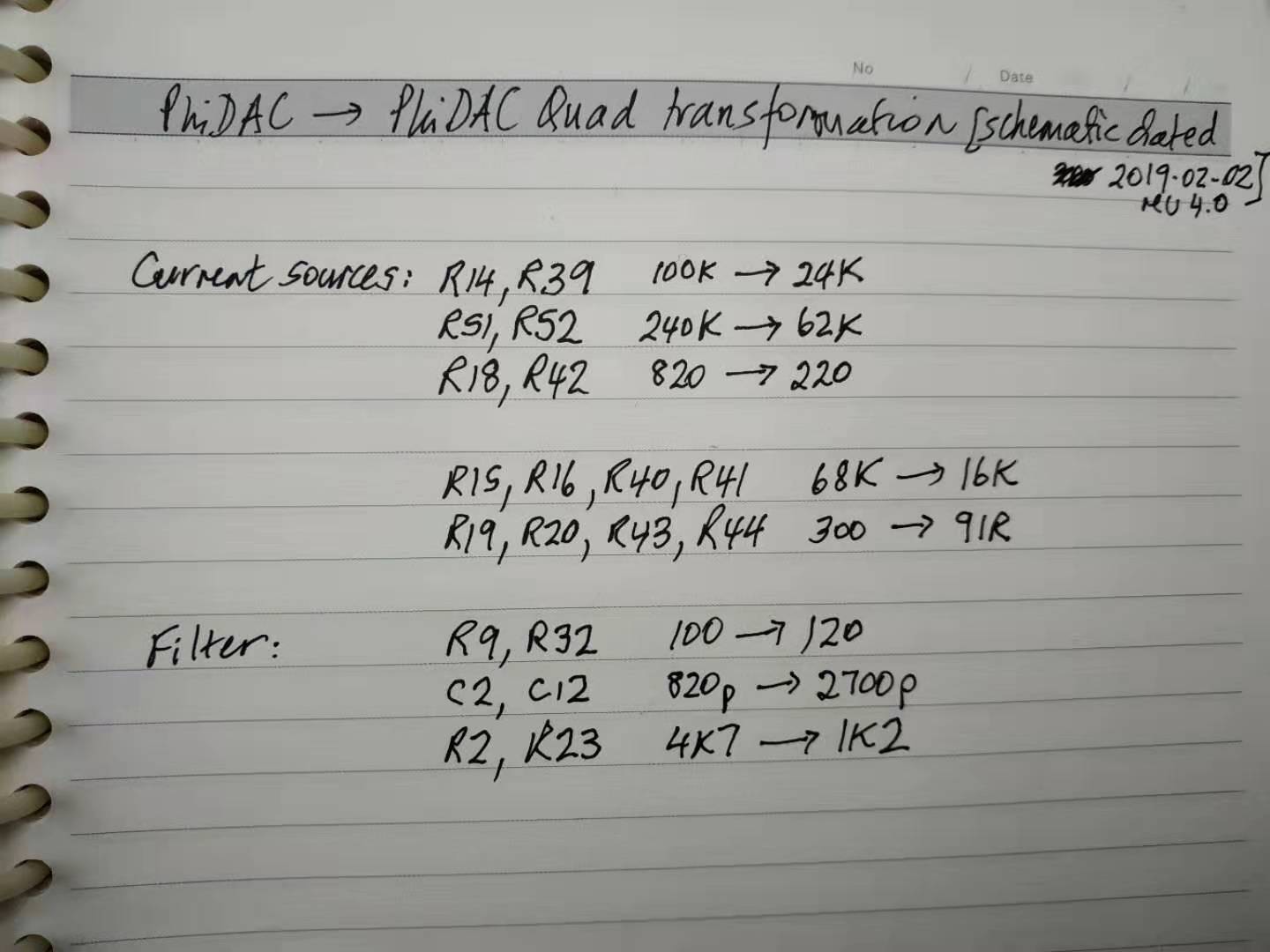
I am actually very curious about what a 2 chip dac would sound like. If it were a halfway between the lush midrange of the single and the clean precision of the 4 chip, that would be worth trying out.
Richard, could you calculate the necessary values to try a 2x dac?
Here is what he said.
"On your first question, I don't know. I haven't tried with just 2 chips, I figured why not stack up 4 for a first attempt as that'll give 6dB reduction in DAC noise and also improve the SNR of the following stages (by increasing the S without changes to the N). 4 chips is about the limit for the first filter which is made up of tiny (0805) inductors with a maximum current rating of 5mA (each DAC chip, running on 6V contributes 1.2mA).
The filter that needs to change for 4 chips isn't the first stage (CLC) one, its the second stage (active) one. That changes because its not just a filter, its also a gain stage and we need lowered gain when the DACs put out more current. If we didn't lower the gain the output would clip at -12dBfs because we have 4X as much current. When the gain changes, the last stage capacitor also needs to change as its bootstrapped around the opamp - with less gain the cap gets less bootstrapping and hence its effective capacitance goes down. So we just increase its value (820pF to 2n7) to compensate."
__________________
Science advances one funeral at a time - Max Planck
I am actually very curious about what a 2 chip dac would sound like. If it were a halfway between the lush midrange of the single and the clean precision of the 4 chip, that would be worth trying out.
Richard, could you calculate the necessary values to try a 2x dac?
Last edited:
Here's my stab at the components for a 2 DAC version.
R14,R39 - 51k
R51,R52 - 120k
R18,R42 - 390R
R15 etc 33k
R19 etc 150R
R9,R32 100R (same)
C2,C12 1500p
R2,R23 2k4
By the way, loving reading all the descriptions of how the 4DAC version sounds 🙂
The downside of more DAC chips is more power supply modulation. I have a gash circuit to reduce that effect, will post up some details in the next couple of days. Might be worth a try on the 4DAC variant, on 2DAC just add two more chips (loaded with same I/V resistance) running on inverted data to cancel out supply ripple.
R14,R39 - 51k
R51,R52 - 120k
R18,R42 - 390R
R15 etc 33k
R19 etc 150R
R9,R32 100R (same)
C2,C12 1500p
R2,R23 2k4
By the way, loving reading all the descriptions of how the 4DAC version sounds 🙂
The downside of more DAC chips is more power supply modulation. I have a gash circuit to reduce that effect, will post up some details in the next couple of days. Might be worth a try on the 4DAC variant, on 2DAC just add two more chips (loaded with same I/V resistance) running on inverted data to cancel out supply ripple.
Based on your experience, does the single chip also sound more midrange forward compared to the 4 chip version?
The most noticeable thing for me when going up to 4 chips was how much extra 'background' information there was. So perhaps less background = more forward foreground? I didn't specifically notice anything change particular to the mid though, could be I was so distracted by the additional detail in the background.
Visualizing the difference
I put a little graphic together that illustrates what I think I am hearing.
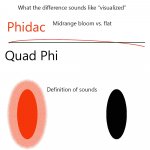
I wish there was a switch where I could flip from one to the other. The original sounds downright dreamy with the right music. Lounge, blues and the like.
This album for instance YouTube
The single phidac makes you melt away and float off into sonic bliss.
On the other hand acoustic, vocal and electronic shine with the speed and clarity of the quad.
YouTube
This one really showed how voices are either completely delineated on the quad or have a halo with the single. The strings on the guitar are also more dimensional on the quad.
Richard, hats off on such a great sounding dac.
I put a little graphic together that illustrates what I think I am hearing.

I wish there was a switch where I could flip from one to the other. The original sounds downright dreamy with the right music. Lounge, blues and the like.
This album for instance YouTube
The single phidac makes you melt away and float off into sonic bliss.
On the other hand acoustic, vocal and electronic shine with the speed and clarity of the quad.
YouTube
This one really showed how voices are either completely delineated on the quad or have a halo with the single. The strings on the guitar are also more dimensional on the quad.
Richard, hats off on such a great sounding dac.
The most noticeable thing for me when going up to 4 chips was how much extra 'background' information there was. So perhaps less background = more forward foreground? I didn't specifically notice anything change particular to the mid though, could be I was so distracted by the additional detail in the background.
I think this is right, Richard. One of the most endearing tricks that TDA1387 has to offer has to do with this question of focus. Even a single chip does not erase background details (they are always there if I listen for them), but it does put the spotlight on the actual music in the foreground, such that all sounds are layered deeply and realistically. With this "front seat" focus, the recording space often disappears in the mix, bringing the performance into my room in a pleasantly spooky way. Other DACs with more focus on background detail are different—more like listening into another space where the music was recorded.
Last edited:
I put a little graphic together that illustrates what I think I am hearing.
Pelopidas, I love the visual and again, I think we are hearing the same thing. The halo metaphor is a good one. Didn't you originally say that 4 chips gave fulller bass? Your sketched FR lines give the opposite impression.
I am a visual thinker and learner. When I first heard TDA1387, the only way I could think of to describe the sound of NOS playback was to use visual examples. To me, oversampling can be a bit like Photoshop's "unsharp mask" filter--overzealously adding detail can flatten natural depth.
The bass is not fuller in the sense of there being more, but the details in the bass are clearer. It's not so much a quantity but a quality change and that is not something I can do on a simple 2D illustration. The image shows what the midrange bloom sounds like, in an image. More lush and full sounding in the bass and then recessing in the treble.
The quad has all the bass and it has interesting definition that was not really perceptible ( I never noticed it until the quad ) but it is as deep and full, just tighter.
The thing I find most surprising is that the quad resists tuning with capacitors. I am using all the same caps as I did on the first one but any addition beyond just the Muse Bipolars is a step down. I have never had any amp or dac that I didn't like better with some Silmic or Nichicon KZ. I am not saying I am done experimenting but it is so damn good right now everything either has no effect or a negative one.
The quad has all the bass and it has interesting definition that was not really perceptible ( I never noticed it until the quad ) but it is as deep and full, just tighter.
The thing I find most surprising is that the quad resists tuning with capacitors. I am using all the same caps as I did on the first one but any addition beyond just the Muse Bipolars is a step down. I have never had any amp or dac that I didn't like better with some Silmic or Nichicon KZ. I am not saying I am done experimenting but it is so damn good right now everything either has no effect or a negative one.
A midrange hump is in result of how we perceive distortions. On some level of distortions processing power of our brain is insufficient which affect the most in our recognition what is happening in the background. A bass is affected, as we fail to register harmonics that fall in the most audible range. We may confuse these tones with distortions, it is why a bass is not reproduced with all nuances. Whathether it is, a small amount of distortions may have a pleasing effect, but the increased value starts to cause irritation, it is why a midrange is perceived louder. It happens at the levels before we start to hear distortions in the sound as a distortions.
This perception vs. distortions is non-linear and levels depend on the individual. If you find a difference with two DAC chips, it doesn't mean that the other person will find the same. If a four chips gives a real difference, I would stay with four, it gives a bigger margin to accomodate others.
As for the resistance to adding capacitors, it is probably caused by the oscilations between different type of capacitors. @abraxalito is known that he makes extensive listening tests before publishing a project. If you add more high capacity devices, you need to reserve a space for a some film caps like a Wima 100nF MKP per a few miliFarads of electrolytic. This is a common practice, but I don't know how it will pair with on-board ceramics. There are more experienced users able to take on this matter.
This perception vs. distortions is non-linear and levels depend on the individual. If you find a difference with two DAC chips, it doesn't mean that the other person will find the same. If a four chips gives a real difference, I would stay with four, it gives a bigger margin to accomodate others.
As for the resistance to adding capacitors, it is probably caused by the oscilations between different type of capacitors. @abraxalito is known that he makes extensive listening tests before publishing a project. If you add more high capacity devices, you need to reserve a space for a some film caps like a Wima 100nF MKP per a few miliFarads of electrolytic. This is a common practice, but I don't know how it will pair with on-board ceramics. There are more experienced users able to take on this matter.
Last edited:
A midrange hump is in result of how we perceive distortions. On some level of distortions processing power of our brain is insufficient which affect the most in our recognition what is happening in the background. A bass is affected, as we fail to register harmonics that fall in the most audible range. We may confuse these tones with distortions, it is why a bass is not reproduced with all nuances. Whathether it is, a small amount of distortions may have a pleasing effect, but the increased value starts to cause irritation, it is why a midrange is perceived louder. It happens at the levels before we start to hear distortions in the sound as a distortions.
I have come to believe that most of us like a little distortion. The last time I was in a recording studio, I watched with amusement as the engineer used "vintage console" type plugins to apply distortion to EVERY track AND the entire mix in Pro Tools. The result didn't sound dirty...it sounded fuller, sharper, and more realistic.
Back to PhiDAC...What I can't figure out is how reducing distortion by adding chips can increase apparent brightness. Pelopidas, I am not questioning your hearing! I just would like to understand the mechanism at work.
It would seem that more distortion harmonics above the fundamental tones (from fewer chips) would tilt overall output toward the higher ranges. But maybe TDA1387's distortion varies with frequency, causing the mid hump, or maybe it is all a matter of perception, wherein an improvement in treble clarity gives an apparent increase in treble output.
Based on your reports I am predicting that the Goldilocks zone for me would be two chips...
Last edited:
Back to PhiDAC...What I can't figure out is how reducing distortion by adding chips can increase apparent brightness. Pelopidas, I am not questioning your hearing! I just would like to understand the mechanism at work.
Could be an erroneous pre-supposition. When I did measurements of my earliest prototype Phi4 I measured increased distortion at higher frequencies, due to the inductors being used getting closer to their max current rating. Which is why I went for more 'industrial' grade inductors on Phi6, for better current handling. In my understanding more chips might well lower distortion (assuming no bottleneck in inductors or anything else downstream) but I've not measured any differences (not that I've looked particularly hard). What more chips undoubtedly does is lower noise.
...The result didn't sound dirty...it sounded fuller, sharper, and more realistic...
Not really. Sometimes its a trick. There was an infamous plugin called 'Vintage Warmer' which added distortion and turned up the volume by 3dB at the same time. The trick was they didn't let on about the hidden volume increase. Without that it sounded worse.
In more recent times the vintage distorter plugins are to mask problems in musical performances, crappy sounding ADCs, etc. There are a few analog hardware boxes that can sometimes make a recording sound subjectively better, but not always.
What more chips undoubtedly does is lower noise.
Ah. Thanks for that correction.
- Home
- Source & Line
- Digital Line Level
- lingDAC - cost effective RBCD multibit DAC design